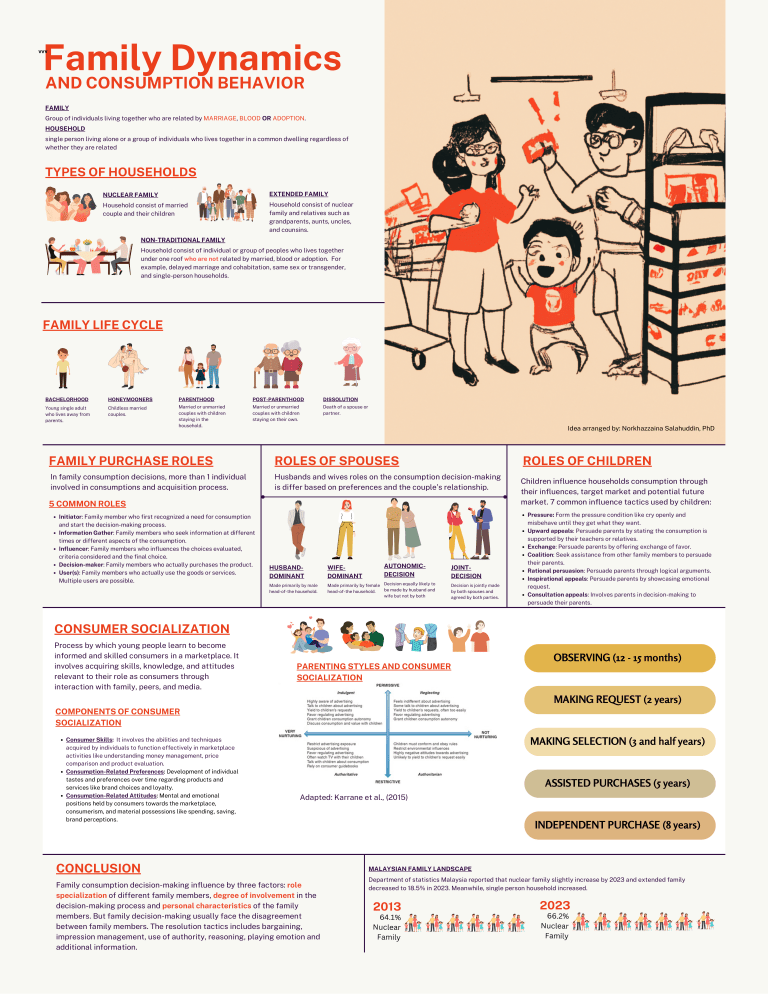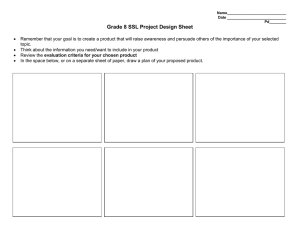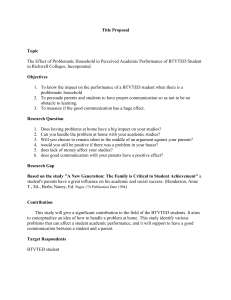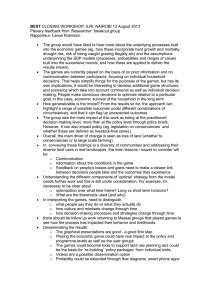
Family Dynamics vvv AND CONSUMPTION BEHAVIOR FAMILY Group of individuals living together who are related by MARRIAGE, BLOOD OR ADOPTION. HOUSEHOLD single person living alone or a group of individuals who lives together in a common dwelling regardless of whether they are related TYPES OF HOUSEHOLDS NUCLEAR FAMILY EXTENDED FAMILY Household consist of married couple and their children Household consist of nuclear family and relatives such as grandparents, aunts, uncles, and counsins. NON-TRADITIONAL FAMILY Household consist of individual or group of peoples who lives together under one roof who are not related by married, blood or adoption. For example, delayed marriage and cohabitation, same sex or transgender, and single-person households. FAMILY LIFE CYCLE BACHELORHOOD HONEYMOONERS PARENTHOOD POST-PARENTHOOD DISSOLUTION Young single adult who lives away from parents. Childless married couples. Married or unmarried couples with children staying in the household. Married or unmarried couples with children staying on their own. Death of a spouse or partner. Idea arranged by: Norkhazzaina Salahuddin, PhD FAMILY PURCHASE ROLES ROLES OF SPOUSES ROLES OF CHILDREN In family consumption decisions, more than 1 individual involved in consumptions and acquisition process. Husbands and wives roles on the consumption decision-making is differ based on preferences and the couple’s relationship. 5 COMMON ROLES Initiator: Family member who first recognized a need for consumption and start the decision-making process. Information Gather: Family members who seek information at different times or different aspects of the consumption. Influencer: Family members who influences the choices evaluated, criteria considered and the final choice. Decision-maker: Family members who actually purchases the product. User(s): Family members who actually use the goods or services. Multiple users are possible. AUTONOMICDECISION HUSBANDDOMINANT WIFEDOMINANT Made primarily by male head-of-the household. Made primarily by female Decision equally likely to be made by husband and head-of-the household. wife but not by both JOINTDECISION Decision is jointly made by both spouses and agreed by both parties. Children influence households consumption through their influences, target market and potential future market. 7 common influence tactics used by children: Pressure: Form the pressure condition like cry openly and misbehave until they get what they want. Upward appeals: Persuade parents by stating the consumption is supported by their teachers or relatives. Exchange: Persuade parents by offering exchange of favor. Coalition: Seek assistance from other family members to persuade their parents. Rational persuasion: Persuade parents through logical arguments. Inspirational appeals: Persuade parents by showcasing emotional request. Consultation appeals: Involves parents in decision-making to persuade their parents. CONSUMER SOCIALIZATION Process by which young people learn to become informed and skilled consumers in a marketplace. It involves acquiring skills, knowledge, and attitudes relevant to their role as consumers through interaction with family, peers, and media. PARENTING STYLES AND CONSUMER SOCIALIZATION OBSERVING (12 - 15 months) MAKING REQUEST (2 years) COMPONENTS OF CONSUMER SOCIALIZATION Consumer Skills: It involves the abilities and techniques acquired by individuals to function effectively in marketplace activities like understanding money management, price comparison and product evaluation. Consumption-Related Preferences: Development of individual tastes and preferences over time regarding products and services like brand choices and loyalty. Consumption-Related Attitudes: Mental and emotional positions held by consumers towards the marketplace, consumerism, and material possessions like spending, saving, brand perceptions. MAKING SELECTION (3 and half years) ASSISTED PURCHASES (5 years) Adapted: Karrane et al., (2015) CONCLUSION Family consumption decision-making influence by three factors: role specialization of different family members, degree of involvement in the decision-making process and personal characteristics of the family members. But family decision-making usually face the disagreement between family members. The resolution tactics includes bargaining, impression management, use of authority, reasoning, playing emotion and additional information. INDEPENDENT PURCHASE (8 years) MALAYSIAN FAMILY LANDSCAPE Department of statistics Malaysia reported that nuclear family slightly increase by 2023 and extended family decreased to 18.5% in 2023. Meanwhile, single person household increased. 2013 64.1% Nuclear Family 2023 66.2% Nuclear Family




